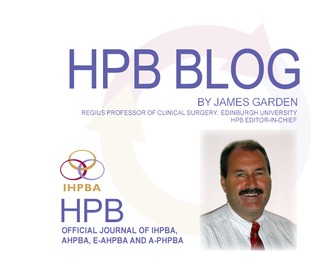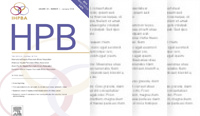International Hepato-Pancreato-Biliary Association
HPB Blog: December 2015

This December issue of HPB brings to a close a wonderful association with our publisher, Wiley. It is intriguing to look back and see what our editorial team has achieved since 2009 with your support. We secured a new look for HPB with enhanced visibility on PubMed, indexing of the Journal by the National Library of Medicine and we delivered on our mission to not just secure but surpass an impact factor of 2 in the journal’s first five years of its new editorship. This has resulted in increased online readership, more downloads of journal content and an increased submission rate of manuscripts.
The quality of these submitted manuscripts continues to impress and this month’s issue is testament also to the breadth of subject matter that we now attract. We are delighted to receive quality basic science or laboratory research that translates into addressing important clinical questions such as that from Croome and his colleagues from the Mayo Clinic. This group has developed a robust animal model of the associating liver partition and portal vein ligation procedure (ALPPS), a procedure that is very much in vogue but is still trying to find its niche. Similarly, we welcome large case series such as that from Herbert and colleagues who attempt to better define risk prediction in patients at particular risk of posthepatectomy liver failure. They analysed 1528 major hepatectomy patients to explore the dynamics of serum phosphate and creatinine in the immediate post-op period, and have delivered data to suggest that these parameters may be of value clinically. Shen and colleagues go a step further and have added to the growing body of literature exploring the impact of hepatic and vascular resection on peri-operative morbidity and mortality in patients undergoing surgical resection for hepatobiliary malignancy. The strength of the study is that it represents a population-based analysis which is likely to be closer to reality than the more frequently reported single institution experience. The challenge for journal reviewers and editors is often to understand whether the favourable outcome in such a single institution experience is down to patient or procedure selection or to surgeon factors.
So what more can we do in 2016 and beyond to ensure that HPB remains valued by the membership and the wider HPB surgical community? How do we advance its profile and impact factor? The only way in which I can see that HPB will be secure as the leading journal in our specialty will be if the members and readership continue to submit their best work to HPB. Look at some of the top quality articles that have better informed us over the last 5 years. Contributors have emphasized the importance of quality pathological analysis of resection specimens in the study of Delpero [Pancreaticoduodenectomy for pancreatic ductal adenocarcinoma: a French multicentre prospective evaluation of resection margins in 150 evaluable specimens Delpero JR et al. 16(1) 20-23 2014] and reporting these in a consistent and agreed manner as advocated by Verbeke [Resection margins in pancreatic cancer: are we entering a new era? Verbeke CS. 16(1) 1-2 2014]. It is not just about outcomes, we like to see an emphasis on quality surgery and our own Asia-Pacific editor, Saxon Connor, has led the reporting of a standardized method for safer gallbladder surgery [Using a standardized method for laparoscopic cholecystectomy to create a concept operation-specific checklist Connor SJ et al. 16(5) 422-429 2014]. Mirnezami and his colleagues have also pulled together useful evidence on the technical aspects of liver surgery [Short- and long-term outcomes after laparoscopic and open hepatic resection: Systematic review and meta-analysis Mirnezami R et al. 13 (5), 295-308?2011].
We know that the readership like accessing this good quality clinical evidence as is apparent form the frequent downloads of Lam and his colleagues’ systematic review on liver-first approach to colorectal liver metastases [A systematic review of a liver-first approach in patients with colorectal cancer and synchronous colorectal liver metastases. Lam VWT et al. 16(2) 101-108 2014]. Similarly, readers have been drawn to systematic reviews on enhanced recovery after liver surgery with [Enhanced recovery following liver surgery: a systematic review and meta-analysis. Hughes MJ et al. 16 (8) 699-706; 2014], or without a meta-analysis [A systematic review of outcomes in patients undergoing liver surgery in an enhanced recovery after surgery pathways. Coolsen et al. 15(4) 245-251; 2013].
We have been fortunate to enjoy the support of the authors of key consensus statements such as those on the selection of patients for hepatic resection [Selection for hepatic resection of colorectal liver metastases: expert consensus statement. Reid B. Adams et al. 15 (2) 91-103; 2013], locoregional therapies [Locoregional surgical and interventional therapies for advanced colorectal liver metastasis: expert consensus statement. Martin et al. 15 (2) 131-133 2013] and cytotoxic and biologic therapies [Systemic cytotoxic and biological therapies of colorectal liver metastases: expert consensus statement. Schwarz RE et al. 15(2) 106-115 2013] for colorectal liver metastases.
Those considering whether HPB will take their manuscript need to give thought to how their work adds to the existing knowledge base on the subject. We like big data studies that seek to deliver evidence to a well-defined clinical question such as the added risk of portal hypertension in the stable cirrhotic patient [Hepatic resection for hepatocellular carcinoma in patients with Child–Pugh's A cirrhosis: is clinical evidence of portal hypertension a contraindication? Santambrogio et al. 15(1) 78-84 2013] or on better defining risk in a specific procedure such as pancreatic resection [Pancreatectomy risk calculator: An ACS-NSQIP resource Parikh P et al. 12(7) 488-497 2010]
We are setting our standards high for 2016. We sincerely hope that you will join us on the great journey to increase further the standing of HPB in the surgical journal ranks!
James Garden
Click here for the December Table of Contents
Click here for the latest Virtual Journal Club discussion
Corporate Partners
If you are interested in becoming a Corporate Partner of the IHBPA please contact industry@ihpba.org
Find out more


